skip to main |
skip to sidebar
In November 2014, I spent a weekend in Vienna with my friend Rita. Our first day is described here. The morning of the second day is described below.
Events of Saturday morning, 8th November 2014
Each of our apartments had an outside balcony provided with table and chairs but, curiously, both were protected by high walls offering only views of the sky. My sitting room also had a tiny balcony situated at the rear corner of the hotel, giving views of the pedestrianised Kartnerstrasse. This is a major shopping area lined with designer stores and the (now obligatory) fast food outlets like McDonalds. Early on Saturday morning, there were few pedestrians as yet but, instead, a number of lorries were delivering new stock to the various retailers.
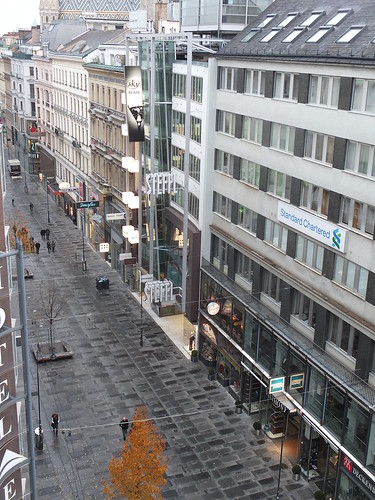 Kartnerstrasse viewed from my balcony.
Kartnerstrasse viewed from my balcony.
Glimpses of various landmarks were also visible from the balcony with St. Stephen's Cathedral, which the Viennese affectionately call "the Steffl" dominating the scene. St. Stephen's was first recorded in the 13th century but the 174m-tall south tower was started in 1359, taking 74 years to complete.
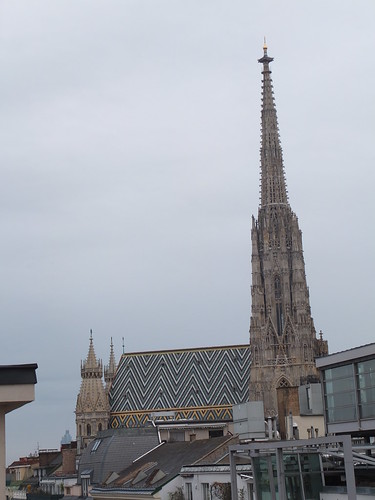
St. Stephen's Cathedral viewed from my balcony.
The hotel offered an excellent buffet breakfast in the restaurant. In addition to the main restaurant, there is a modern all-glass extension they call the Wintergarden, offering views of the Neuer Markt and the city waking up.
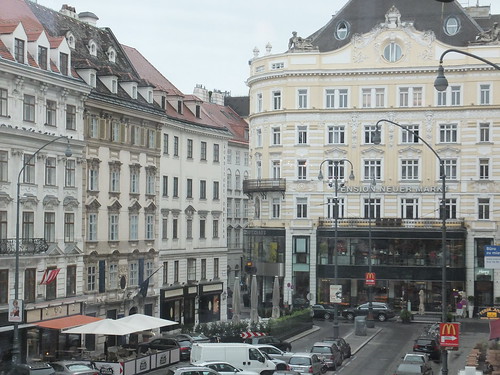 View of the Neuer Markt from the Wintergarden at the Ambassador. Note the red street signs directing pedestrians to McDonalds.
View of the Neuer Markt from the Wintergarden at the Ambassador. Note the red street signs directing pedestrians to McDonalds.
My friend Rita was also keen to visit the Spanish Riding School which claims "The Spanish Riding School in Vienna is the only institution in the world which has practiced for nearly 450 years and continues to cultivate classical equitation in the Renaissance tradition of the haute école. The objective of classical equitation is to study the way the horse naturally moves and to cultivate the highest levels of haute école elegance the horse is capable of through systematic training. The result creates an unparalleled harmony between rider and horse, as only Vienna's Spanish Riding School achieves". Various public performances are given but we found that these were already fully booked for days ahead. However, admission to the morning training sessions does not require pre-booking so we obtained directions from the hotel and decided that we would walk there. We threaded our way through the tangle of narrow streets approaching the Hofburg - a complex of buildings built in different periods which served the Habsburg Dynasty for over 600 years. Having passed St. Augustine's Church, we entered Josefplatz Square with its equestrian statue of Emperor Josef II. The Square is flanked by the Redouten Halls and the Grand Hall, with an entrance to the National Library.
 Josefplatz Square.
Josefplatz Square.
We were surprised to encounter a group of the famous Lipizzaner horses being led by uniformed grooms from right to left across the street we were on, the Reitschulgasse. The horses had emerged from a courtyard on the right which was clearly the stables. Only later did I discover that the Stallburg Wing containing the stables is part of the 16th century Imperial Palace built by Emperor Ferdinand I. A few years ago, the inner courtyard was provided with a moveable roof, allowing the space to be hired out for dinners or other functions. You can read more about the Stallburg here.
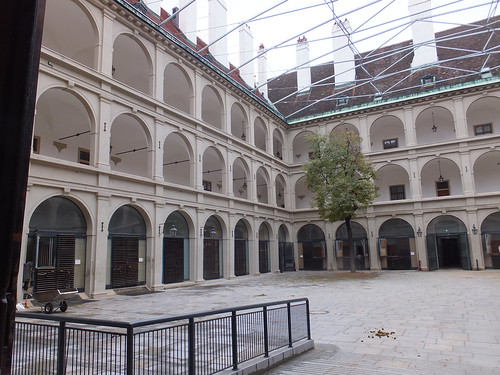 The Stallburg. Note the framework over the inner courtyard to support the removeable roof. A groom will presumably be along shortly to use the equipment on the left to remove the horse droppings on the right.
The Stallburg. Note the framework over the inner courtyard to support the removeable roof. A groom will presumably be along shortly to use the equipment on the left to remove the horse droppings on the right.
St. Michael's Square was being set up for a function I didn't work out with various temporary stages and sound systems. The impressive curved facade of St. Michael's Wing on our left was built in 1888, implementing a plan originally proposed in 1726. St. Michael's Gate in this facade leads to the Imperial Silverware Collection, the Imperial Apartments and the Empress Elisabeth Museum (usually called the 'Sisi Museum'). A smaller gateway leads to the Spanish Riding School.
 The facade of St. Michael's Wing.
The facade of St. Michael's Wing.
A modern box office was rapidly issuing tickets for the morning training session which was already in progress. The training takes place in the Winter Riding School. This is a large, fairly grand rectangular building, illuminated by three large chandeliers. There is a sand-covered area at ground level for the horses and riders. All four sides are flanked by galleries at low level and high level and both sets of galleries were full. We only obtained seats because a young family insisted on giving up their seats.
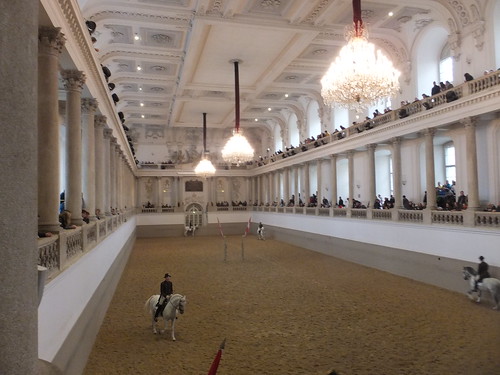 The Winter Riding School.
The Winter Riding School.
Five horses were being exercised to music played over a system of loudspeakers. There were four male riders and one lady, all dressed in bicorn hats and riding coats. At the end of that training session, the horses were lined up, the riders dismounted and five grooms appeared, placed a bridle on each horse and led them back to the stables. Presently, another set of horses were brought in, the riders re-appeared and another session started. Training horses to the necessary standard takes place over a period of years. I noticed what I took to be the Riding Master watching from seats at ground level. He was similarly attired to the riders, with the addition of a greatcoat. A couple of times, he signalled to the lady rider and stood up to discuss some point with her. Later, he called over one of the male riders. Once again, the riders lined up, dismounted and grooms took the horses away. For the final period, six horses were brought in and a voice over the loudspeakers announced that the school's latest rider would be taking part. This proved to be another lady but, presumably because she is not yet deemed fully qualified, rather than wearing the bicorn hat and riding coat, she was in groom's uniform. Another training session took place, this time with six horses criss-crossing the arena at varying speeds. When this last group of horses had finished and been led back to the stables, the spectators made their way out to the cafe and souvenir shop.
Rita and I had a snack in the cafe and became involved in conversation with three middle-aged Dutch gentlemen. The one man was an arable farmer and, unprompted, he announced that he was firmly in favour of the European Union with its common currency and freedom of movement. Whilst professing fondness for the English, he felt that there was no room for 'semi-detached' members and that the UK should 'shape up or ship out'. Rita made some puchases in the well-stocked souvenir shop.
In St. Michael's Square, there were a number of the four-wheeled horse-drawn carriages which the French call 'fiacre' but in Vienna are called 'fiaker'. There's a little history on Wikipedia here. However, we decided to walk back to our hotel for a 'breather' before taking a bus tour of the city in the afternoon.
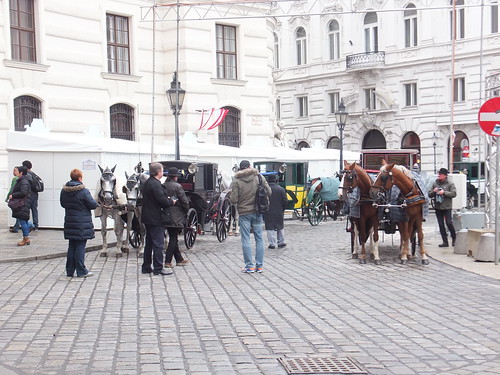 Fiaker plying for hire in St. Michael's Square.
Fiaker plying for hire in St. Michael's Square.
Related posts on this website
A Weekend in Vienna (Part 1).
A Weekend in Vienna (Part 3).
A Weekend in Vienna (Part 4).
A Weekend in Vienna (Part 5).
Books
[1] 'Imperial Vienna' by Lina Schnorr, published by H.B. Medienvertrieb GesmbH (ISBN: 978-3-9502396-9-0).
[2] 'Vienna: Art and Architecture', by various authors, published by h.f. ullmann (ISBN 978-3-8331-6006-6).
My Pictures
The albums below relate to this post:-
Ambassador Hotel, Wien.
Wien, Austria.
The collection below includes all the albums on the Vienna trip:-
Austria.
My friend Rita wanted to visit Vienna and I promised I'd accompany her. We spent an interesting weekend there, arriving on Friday, 7th November 2014 and returning on Monday, 11th November 2014. The arrangements were made by my usual travel agents, Wexas.
Events of Friday, 7th November 2014
We flew to Vienna by British Airways flight BA700 from Heathrow Terminal 3. The aircraft was an A320 and the flight took around two hours. We were taken into the city by a very smart black saloon. I noticed that it was a hybrid because I was fascinated by the dashboard display showing whether we were running in normal mode, ECO mode or battery charging mode. Every time the driver touched the brakes, regenerative braking put charge into the battery. I think it was a Lexus, but I can't be sure.
On the way to the city, we passed a large oil refinery and a power station and then spent some time threading our way around the narrow, convoluted streets of the old part of the city to arrive at our hotel, the Ambassador, set in the Neuer Markt and overlooking the fountain by Rafael Donner. The Hotel had allocated two interconnected Apartments for us, which gave us lots of space.
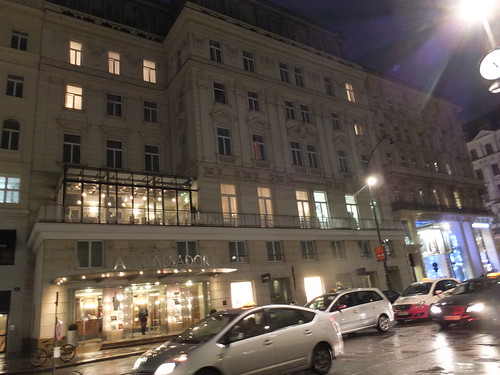 The Ambassador Hotel at night.
The Ambassador Hotel at night.
Rita is an opera enthusiast and was keen to see a performance at the world-famous Wienner Staatsoper, (the Vienna State Opera House). Ballet and Opera alternate and, amazingly, the programme changes virtually every day, presenting major logistical problems. I believe six or seven large lorries arrive each day with scenery for the next performance and the costume department keep track of 150,000 costumes. On our first evening in Vienna, the performance was to be the opera 'La Boheme' by Puccini. When we enquired at our hotel, we were told that the opera was sold out that evening but that there was a possibility of obtaining a ticket at the Opera House.
Told that it would only take a few minutes to walk to the opera house, we obtained directions, borrowed an umbrella (for the evening had turned quite wet) and set off. We located the huge building without too much difficulty and wandered amongst the good-natured crowds assembling outside the building. With around 90 minutes to go before the performance, the doors remained firmly locked. In discussion with other tourists, we gathered that there was a standing area where tickets cannot be pre-booked but which are sold, first come, first served about an hour before the start of the performance. We decided that we'd try this option, although I was worried about Rita having to stand for the length of the performance (about two and a half hours with intervals). Come to that, I was worried about me standing for that length of time.

'Playbill' outside the Opera House (actually a flat-screen display).
When they opened the doors to admit people to the standing area, there was initially a bit of a rush but a queue formed in a long passage inside the opera house. We shuffled along this passage until we reached a small Box Office solely selling tickets for the standing area. We obtained two tickets and moved into the foyer area where stairs led upwards. The opera house seats over 2,200 people and, as you would imagine, ticket prices vary according to location, from around 250 Euros downwards. Our tickets cost 3 Euros, representing excellent value provided you are prepared to stand. People hastened to climb the stairs so as to secure more desirable locations to stand and Rita and I were rather swept along by this, finally arriving at a narrow standing area behind the tiered seating of the uppermost gallery, in an area called in the British theatre "the Gods". There was a separate cloakroom at this level which was rapidly filling with coats and backpacks. I had to surrender the umbrella. It was noticeable that the 'standees' tended to be young or fairly old, informally dressed and included quite a few tourists. Looking towards the 'posh' seats below us, it struck me that the patrons there tended to be middle aged and more formally dressed.

Seating Plan. Click above for the uncropped image.
The standing area is separated from the seating area by a metal handrail with a padded top so at least there's something to lean against. Like all the galleries, the standing area handrail is provided with frequent electronic displays which you can set to present the words being sung in a number of languages. When 'surtitles' started to be provided in operas, there was some criticism from traditionalists but I found the arrangements helpful and unobtrusive.
Although the standing space is unreserved, there is an informal tradition that, once you have found a suitable spot, you can 'reserve' it by marking the section of railing with a scarf or by hanging printed programme notes on the railing. Once having 'claimed' a spot, the opera-goer can go for refreshments or whatever confident that the space will remain unoccupied. I rather liked the courtesy of this system. It was also apparent that standees tend to be enthusiasts, there for the performance rather than 'to be seen'. One lady we talked to attends around ten performances a month in this way. A lady teacher from Finland we'd queued with insisted on fetching refreshments for Rita and myself. All-in-all I found it a very friendly experience.
The performance was due to start at 7.00 p.m. With ten minutes to go, the auditorium rapidly filled up until I couldn't see a spare seat anywhere. The standing area was crowded, too. Our spot was near the stage which is supposed to be good for sound but meant we could only see about half of the stage. At the same time, the large orchestra were assembling in the orchestra pit.
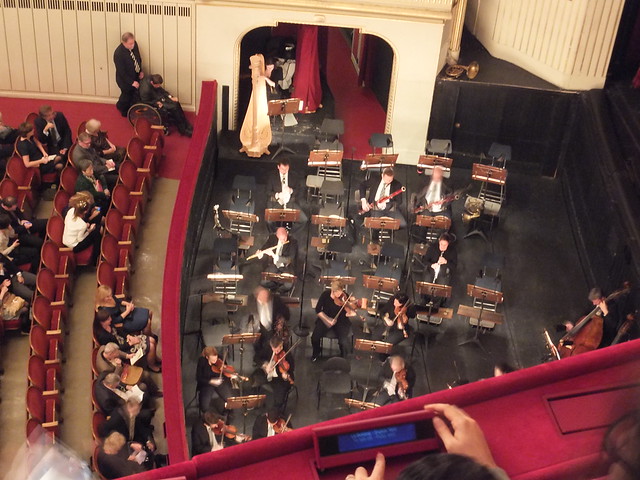 With a few minutes to go, this was our view of the orchestra pit with the stage on the right. Members of the orchestra were taking their places and by the time the performance started, all the seats in the auditorium were filled. On the right at the bottom of the picture, one of the electronic displays can be seen.
With a few minutes to go, this was our view of the orchestra pit with the stage on the right. Members of the orchestra were taking their places and by the time the performance started, all the seats in the auditorium were filled. On the right at the bottom of the picture, one of the electronic displays can be seen.
We then enjoyed 'La Boheme' performed by world-class musicians and artists.
On the way out, I was able to see more of the elaborate foyers and entrance hall. When the building was opened in 1869, it was not immediately popular with the public. The auditorium and stage were badly damaged at the end of World War II, requiring elaborate reconstruction in a somewhat modernised style. The entrance area remains largely as originally constructed. There's more information in the Wikipedia article here.

Patrons leaving via the impressive entrance hall at the Vienna Opera House.
Rita and I walked back to our hotel. The restaurant had closed, but we were able to enjoy a light meal in the rather grand bar area before retiring for the night.
 The bar area at the Ambassador, viewed from above.
The bar area at the Ambassador, viewed from above.
Related posts on this website
A Weekend in Vienna (Part 2).
A Weekend in Vienna (Part 3).
A Weekend in Vienna (Part 4).
A Weekend in Vienna (Part 5).
Books
[1] 'Imperial Vienna' by Lina Schnorr, published by H.B. Medienvertrieb GesmbH (ISBN: 978-3-9502396-9-0).
[2] 'Vienna: Art and Architecture', by various authors, published by h.f. ullmann (ISBN 978-3-8331-6006-6).
My Pictures
The albums below relate to this post:-
Ambassador Hotel, Wien.
Wien, Austria.
Vienna State Opera.
The collection below includes all the albums on the Vienna trip:-
Austria.
 Kartnerstrasse viewed from my balcony.
Kartnerstrasse viewed from my balcony.

 View of the Neuer Markt from the Wintergarden at the Ambassador. Note the red street signs directing pedestrians to McDonalds.
View of the Neuer Markt from the Wintergarden at the Ambassador. Note the red street signs directing pedestrians to McDonalds.
 Josefplatz Square.
Josefplatz Square.
 The Stallburg. Note the framework over the inner courtyard to support the removeable roof. A groom will presumably be along shortly to use the equipment on the left to remove the horse droppings on the right.
The Stallburg. Note the framework over the inner courtyard to support the removeable roof. A groom will presumably be along shortly to use the equipment on the left to remove the horse droppings on the right.
 The facade of St. Michael's Wing.
The facade of St. Michael's Wing.
 The Winter Riding School.
The Winter Riding School.
 Fiaker plying for hire in St. Michael's Square.
Fiaker plying for hire in St. Michael's Square.





